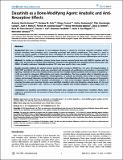Por favor, use este identificador para citar o enlazar a este item:
http://hdl.handle.net/10261/60019COMPARTIR / EXPORTAR:
 SHARE SHARE
 CORE
BASE CORE
BASE
|
|
| Visualizar otros formatos: MARC | Dublin Core | RDF | ORE | MODS | METS | DIDL | DATACITE | |

| Título: | Dasatinib as a bone-modifying agent: Anabolic and anti-resorptive effects |
Autor: | García-Gómez, Antonio; Ocio, Enrique M. CSIC ORCID ; Crusoe, Edvan; Santamaría, Carlos; Hernández-Campo, Pilar M.; Blanco, Juan F.; Sánchez-Guijo, Fermín M. CSIC ORCID; Hernández, Mª Teresa; Pandiella, Atanasio CSIC ORCID CVN ; San Miguel, Jesús F. CSIC ORCID; Garayoa, Mercedes CSIC ORCID ; Briñón, Jesús G. | Fecha de publicación: | 2012 | Editor: | Public Library of Science | Citación: | PLoS ONE 7(4): e34914 (2012) | Resumen: | [Background]: Bone loss, in malignant or non-malignant diseases, is caused by increased osteoclast resorption and/or reduced osteoblast bone formation, and is commonly associated with skeletal complications. Thus, there is a need to identify new agents capable of influencing bone remodeling. We aimed to further pre-clinically evaluate the effects of dasatinib (BMS-354825), a multitargeted tyrosine kinase inhibitor, on osteoblast and osteoclast differentiation and function. [Methods]: For studies on osteoblasts, primary human bone marrow mensenchymal stem cells (hMSCs) together with the hMSC-TERT and the MG-63 cell lines were employed. Osteoclasts were generated from peripheral blood mononuclear cells (PBMC) of healthy volunteers. Skeletally-immature CD1 mice were used in the in vivo model. [Results]: Dasatinib inhibited the platelet derived growth factor receptor-β (PDGFR-β), c-Src and c-Kit phosphorylation in hMSC-TERT and MG-63 cell lines, which was associated with decreased cell proliferation and activation of canonical Wnt signaling. Treatment of MSCs from healthy donors, but also from multiple myeloma patients with low doses of dasatinib (2-5 nM), promoted its osteogenic differentiation and matrix mineralization. The bone anabolic effect of dasatinib was also observed in vivo by targeting endogenous osteoprogenitors, as assessed by elevated serum levels of bone formation markers, and increased trabecular microarchitecture and number of osteoblast-like cells. By in vitro exposure of hemopoietic progenitors to a similar range of dasatinib concentrations (1-2 nM), novel biological sequelae relative to inhibition of osteoclast formation and resorptive function were identified, including F-actin ring disruption, reduced levels of c-Fos and of nuclear factor of activated T cells 1 (NFATc1) in the nucleus, together with lowered cathepsin K, αVβ3 integrin and CCR1 expression. [Conclusions]: Low dasatinib concentrations show convergent bone anabolic and reduced bone resorption effects, which suggests its potential use for the treatment of bone diseases such as osteoporosis, osteolytic bone metastasis and myeloma bone disease. © 2012 Garcia-Gomez et al. | Descripción: | This is an open-access article distributed under the terms of the Creative Commons Attribution License.-- et al. | Versión del editor: | http://dx.doi.org/10.1371/journal.pone.0034914 | URI: | http://hdl.handle.net/10261/60019 | DOI: | 10.1371/journal.pone.0034914 | Identificadores: | issn: 1932-6203 |
| Aparece en las colecciones: | (IBMCC) Artículos |
Ficheros en este ítem:
| Fichero | Descripción | Tamaño | Formato | |
|---|---|---|---|---|
| Dasatinib as.pdf | 1,2 MB | Adobe PDF |  Visualizar/Abrir |
CORE Recommender
PubMed Central
Citations
31
checked on 17-mar-2024
SCOPUSTM
Citations
61
checked on 21-abr-2024
WEB OF SCIENCETM
Citations
61
checked on 23-feb-2024
Page view(s)
488
checked on 23-abr-2024
Download(s)
317
checked on 23-abr-2024

